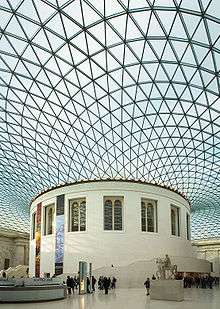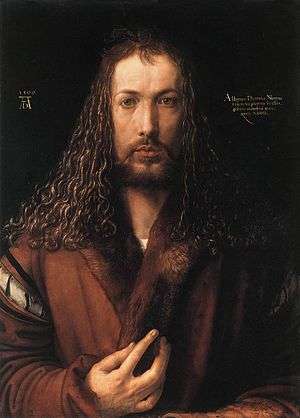Dürer's Rhinoceros
_enhanced.png) | |
| Artist | Albrecht Dürer |
|---|---|
| Year | 1515 |
| Type | Woodcut |
| Dimensions | 23.5 cm × 29.8 cm (9.3 in × 11.7 in) |
| Location | This copy, National Gallery of Art, Washington |
Dürer's Rhinoceros is the name commonly given to a woodcut executed by German painter and printmaker Albrecht Dürer in 1515.[1] The image is based on a written description and brief sketch by an unknown artist of an Indian rhinoceros that had arrived in Lisbon in 1515.[2] Dürer never saw the actual rhinoceros, which was the first living example seen in Europe since Roman times.[2] In late 1515, the King of Portugal, Manuel I, sent the animal as a gift for Pope Leo X, but it died in a shipwreck off the coast of Italy in early 1516. A live rhinoceros was not seen again in Europe until a second specimen, named Abada, arrived from India at the court of Sebastian of Portugal in 1577, being later inherited by Philip II of Spain around 1580.[3][4]
Dürer's woodcut is not an entirely accurate representation of a rhinoceros. He depicts an animal with hard plates that cover its body like sheets of armour, with a gorget at the throat, a solid-looking breastplate, and rivets along the seams. He places a small twisted horn on its back, and gives it scaly legs and saw-like rear quarters. None of these features are present in a real rhinoceros,[5][6] although the Indian rhinoceros does have deep folds in its skin that can look like armor from a distance. Despite its anatomical inaccuracies, Dürer's woodcut became very popular in Europe and was copied many times in the following three centuries. It was regarded by Westerners as a true representation of a rhinoceros into the late 18th century. Eventually, it was supplanted by more realistic drawings and paintings, particularly those of Clara the rhinoceros, who toured Europe in the 1740s and 1750s. It has been said of Dürer's woodcut: "probably no animal picture has exerted such a profound influence on the arts".[7]
The rhinoceros

On 20 May 1515, an Indian rhinoceros arrived in Lisbon from the Far East. In early 1514, Afonso de Albuquerque, governor of Portuguese India, sent ambassadors to Sultan Muzafar II, ruler of Cambay (modern Gujarat), to seek permission to build a fort on the island of Diu. The mission returned without an agreement, but diplomatic gifts were exchanged, including the rhinoceros.[8] At that time, the rulers of different countries would occasionally send each other exotic animals to be kept in a menagerie. The rhinoceros was already well accustomed to being kept in captivity. Albuquerque decided to forward the gift, known by its Gujarati name of ganda, and its Indian keeper, named Ocem, to King Manuel I of Portugal. It sailed on the Nossa Senhora da Ajuda,[9] which left Goa in January 1515.[10] The ship, captained by Francisco Pereira Coutinho,[11] and two companion vessels, all loaded with exotic spices, sailed across the Indian Ocean, around the Cape of Good Hope and north through the Atlantic, stopping briefly in Mozambique, Saint Helena and the Azores.
After a relatively fast voyage of 120 days, the rhinoceros was finally unloaded in Portugal, near the site where the Manueline Belém Tower was under construction. The tower was later decorated with gargoyles shaped as rhinoceros heads under its corbels.[12] A rhinoceros had not been seen in Europe since Roman times: it had become something of a mythical beast, occasionally conflated in bestiaries with the "monoceros" (unicorn), so the arrival of a living example created a sensation. In the context of the Renaissance, it was a piece of classical antiquity which had been rediscovered, like a statue or an inscription.
The animal was examined by scholars and the curious, and letters describing the fantastic creature were sent to correspondents throughout Europe. The earliest known image of the animal illustrates a poemetto by Florentine Giovanni Giacomo Penni, published in Rome on 13 July 1515, fewer than eight weeks after its arrival in Lisbon.[13] The only known copy of the original published poem is held by the Institución Colombina in Seville.
It was housed in King Manuel's menagerie at the Ribeira Palace in Lisbon, separate from his elephants and other large beasts at the Estaus Palace. On Trinity Sunday, 3 June, Manuel arranged a fight with young elephant from his collection, to test the account by Pliny the Elder that the elephant and the rhinoceros are bitter enemies.[14] The rhinoceros advanced slowly and deliberately towards its foe; the elephant, unaccustomed to the noisy crowd that turned out to witness the spectacle, fled the field in panic before a single blow was struck.[15][16]
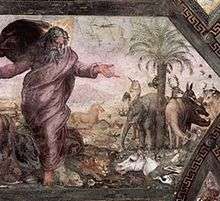
Manuel decided to give the rhinoceros as a gift to the Medici Pope Leo X. The King was keen to curry favour with the Pope, to maintain the papal grants of exclusive possession to the new lands that his naval forces had been exploring in the Far East since Vasco da Gama discovered the sea route to India around Africa in 1498. The previous year, the Pope had been very pleased with Manuel's gift of a white elephant, also from India, which the Pope had named Hanno. Together with other precious gifts of silver plate and spices, the rhinoceros, with its new collar of green velvet decorated with flowers, embarked in December 1515 for the voyage from the Tagus to Rome.[17] The vessel passed near Marseille in early 1516. King Francis I of France was returning from Saint-Maximin-la-Sainte-Baume in Provence, and requested a viewing of the beast. The Portuguese vessel stopped briefly at an island off Marseilles,[18] where the rhinoceros disembarked to be beheld by the King on 24 January.
After resuming its journey, the ship was wrecked in a sudden storm as it passed through the narrows of Porto Venere, north of La Spezia on the coast of Liguria. The rhinoceros, chained and shackled to the deck to keep it under control, was unable to swim to safety and drowned. The carcass of the rhinoceros was recovered near Villefranche, and its hide was returned to Lisbon, where it was stuffed. Some reports say that the mounted skin was sent to Rome, arriving in February 1516, to be exhibited impagliato (Italian for "stuffed with straw"), although such a feat would have challenged 16th-century methods of taxidermy, which were still primitive. If a stuffed rhinoceros did arrive in Rome, its fate remains unknown: it might have been removed to Florence by the Medici, or destroyed in the 1527 sack of Rome. In any event, there was not the popular sensation in Rome that the living beast had caused in Lisbon, although a rhinoceros was depicted in contemporary paintings in Rome by Giovanni da Udine and Raphael.[19][20]
Dürer's woodcut
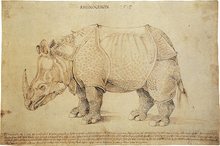
Valentim Fernandes, a Moravian merchant and printer, saw the rhinoceros in Lisbon shortly after it arrived and wrote a letter describing it to a friend in Nuremberg in June 1515. The original letter in German has not survived, but a copy in Italian is held in the Biblioteca Nazionale Centrale in Florence.[22] A second letter of unknown authorship was sent from Lisbon to Nuremberg at around the same time, enclosing a sketch by an unknown artist.[23] Dürer – who was acquainted with the Portuguese community of the factory at Antwerp[24] – saw the second letter and sketch in Nuremberg. He made a pen and ink drawing [25][26] and printed a reversed reflection of it.[20][27]
The German inscription on the woodcut, drawing largely from Pliny's account,[14] reads:
| “ | On the first of May in the year 1513 AD [sic], the powerful King of Portugal, Manuel of Lisbon, brought such a living animal from India, called the rhinoceros. This is an accurate representation. It is the colour of a speckled tortoise,[28] and is almost entirely covered with thick scales. It is the size of an elephant but has shorter legs and is almost invulnerable. It has a strong pointed horn on the tip of its nose, which it sharpens on stones. It is the mortal enemy of the elephant. The elephant is afraid of the rhinoceros, for, when they meet, the rhinoceros charges with its head between its front legs and rips open the elephant's stomach, against which the elephant is unable to defend itself. The rhinoceros is so well-armed that the elephant cannot harm it. It is said that the rhinoceros is fast, impetuous and cunning.[29] | ” |
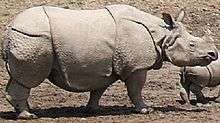
Dürer's woodcut is not an accurate representation of a rhinoceros. He depicts an animal with hard plates that cover its body like sheets of armour, with a gorget at the throat, a solid-looking breastplate, and rivets along the seams. He places a small twisted horn on its back, and gives it scaly legs and saw-like rear quarters. None of these features is present in a real rhinoceros.[5][6] It is possible that a suit of armour was forged for the rhinoceros's fight against the elephant in Portugal, and that these features depicted by Dürer are parts of the armour.[30] Alternatively, Dürer's "armour" may represent the heavy folds of thick skin of an Indian rhinoceros, or, as with the other inaccuracies, may simply be misunderstandings or creative additions by Dürer.[31] Dürer also draws a scaly texture over the body of the animal, including the "armour". This may be Dürer's attempt to reflect the rough and almost hairless hide of the Indian rhinoceros, which has wart-like bumps covering its upper legs and shoulders. On the other hand, his depiction of the texture may represent dermatitis induced by the rhinoceros' close confinement during the four-month journey by ship from India to Portugal.[32]
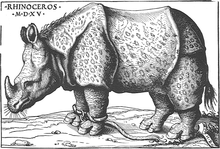
A second woodcut was executed by Hans Burgkmair in Augsburg around the same time as Dürer's in Nuremberg. Burgkmair corresponded with merchants in Lisbon and Nuremberg, but it is not clear whether he had access to a letter or sketch as Dürer did, perhaps even Dürer's sources, or saw the animal himself in Portugal.[33] His image is truer to life, omitting Dürer's more fanciful additions and including the shackles and chain used to restrain the rhinoceros;[33] however, Dürer's woodcut is more powerful and eclipsed Burgkmair's in popularity. Only one impression (example) of Burgkmair's image has survived,[34] whereas Dürer's print survives in many impressions. Dürer produced a first edition of his woodcut in 1515, in the first state, which is distinguished by only five lines of text in the heading.[11] Many further printings followed after Dürer's death in 1528, including two in the 1540s, and two more in the late 16th century.[35] Later printings have six lines of descriptive text.[11]
_-_Rhinoceros_-_BM_1913%2C1015.110.jpg)
The block passed into the hands of the Amsterdam printer and cartographer Willem Janssen (also called Willem Blaeu amongst other names). By this time the block was very damaged; the border lines were chipped, there were numerous woodworm holes and a pronounced crack had developed through the rhino's legs.[36] Janssen decided to re-issue the block with the addition of a new tone block printed in a variety of colours, olive-green and dark green, as well as blue-grey.[37][38] The resulting chiaroscuro woodcut, which entirely omitted the text, was published after 1620.[35][39] There is an example in the British Museum.[37] This was the seventh of the eight editions in all of the print.[38][40]

Despite its errors, the image remained very popular,[6] and was taken to be an accurate representation of a rhinoceros until the late 18th century. Dürer may have anticipated this and deliberately chosen to create a woodcut, rather than a more refined and detailed engraving, as this was cheaper to produce and more copies could be printed.[36] Images derived from it were included in naturalist texts, including Sebastian Münster's Cosmographiae (1544), Conrad Gessner's Historiae Animalium (1551), Edward Topsell's Histoire of Foure-footed Beastes (1607) and many others. A rhinoceros that was clearly based on Dürer's woodcut was chosen by Alessandro de' Medici as his emblem in June 1536, with the motto "Non vuelvo sin vencer" (old Spanish for "I shall not return without victory").[41] A sculpture of a rhinoceros based on Dürer's image was placed at the base of a 70-foot (21 m) high obelisk designed by Jean Goujon and erected in front of the Church of the Sepulchre in the rue Saint-Denis in Paris in 1549 for the royal entry welcoming the arrival of the new King of France, Henry II.[42] A similar rhinoceros, in relief, decorates a panel in one of the bronze west doors of Pisa Cathedral. The rhinoceros was depicted in numerous other paintings and sculptures, and became a popular decoration for porcelain. The popularity of the inaccurate Dürer image remained undiminished despite an Indian rhinoceros spending eight years in Madrid from 1580 to 1588 (although a few examples of a print of the Madrid rhinoceros sketched by Philippe Galle in Antwerp in 1586, and derivative works, have survived), and the exhibition of a live rhinoceros in London a century later, from 1684–86, and of a second individual after 1739.[43]
The pre-eminent position of Dürer's image and its derivatives declined from the mid-to-late-18th century, when more live rhinoceroses were transported to Europe, shown to the curious public, and depicted in more accurate representations. Jean-Baptiste Oudry painted a life-size portrait of Clara the rhinoceros in 1749, and George Stubbs painted a large portrait of a rhinoceros in London around 1790. Both of these paintings were more accurate than Dürer's woodcut, and a more realistic conception of the rhinoceros gradually started to displace Dürer's image in the public imagination. In particular, Oudry's painting was the inspiration for a plate in Buffon's encyclopedic Histoire naturelle, which was widely copied.[45] In 1790, James Bruce's travelogue Travels to discover the source of the Nile dismissed Dürer's work as "wonderfully ill-executed in all its parts" and "the origin of all the monstrous forms under which that animal has been painted, ever since". Even so, Bruce's own illustration of the African white rhinoceros, which is noticeably different in appearance to the Indian rhinoceros, still shares conspicuous inaccuracies with Dürer's work.[46] Semiotician Umberto Eco argues that Dürer's "scales and imbricated plates" became a necessary element of depicting the animal, even to those who might know better, because "they knew that only these conventionalized graphic signs could denote «rhinoceros» to the person interpreting the iconic sign." He also notes that the skin of a rhinoceros is rougher than it visually appears and that such plates and scales portray this non-visual information to a degree.[47]
Until the late 1930s, Dürer's image appeared in school textbooks in Germany as a faithful image of the rhinoceros;[7] and it remains a powerful artistic influence. It was one of the inspirations for Salvador Dalí; a reproduction of the woodcut hung in his childhood home and he used the image in several of his works.[48]
Sale history
Although very popular, few prints have survived and impressions of the first edition are very rare. A fine example was sold at Christie's New York in 2013 for $866,500, setting a new auction record for the artist.[40][49]
Notes
- ↑ Some sources erroneously say 1513, copying a typographical error made by Dürer in one of his original drawings and perpetuated in his woodcut.(Bedini, p.121.)
- 1 2 (French) Joëlle Kuntz, "1515, l’année du rhinocéros", Le Temps, Friday 18 December 2015 (page visited on 21 December 2015).
- ↑ Clarke, chapter 2.
- ↑ A street in Madrid was named Abada (rhinoceros in Portuguese) after this animal, that had a curious life too . (in Spanish)
- 1 2 Group of History and Theory of Science – Dürer's Rhinoceros, State University of Campinas, Brazil.
- 1 2 3 Dürer's Rhinoceros, Kallisti Digital Publishing, 7 March 2003.
- 1 2 Quoted in Clarke, p.20.
- ↑ Bedini, p.112.
- ↑ Clarke, p.16.
- ↑ Bedini, p.113.
- 1 2 3 História do famoso rhinocerus de Albrecht Dürer, Projecto Lambe-Lambe (Portuguese).
- ↑ See Clarke, p.19, for a photograph of a gargoyle.
- ↑ Giovanni Giacomo Penni, Forma e natura e costumi de lo rinocerote (...). See Ugo Serani, Etiopicas 2 (2006) ISSN 1698-689X for the original text in Italian and a translation into Spanish.
- 1 2 Latin original and English translation of Chapter 29, Book VIII of Pliny's Naturalis Historia.
- ↑ Bedini, p.118.
- ↑ "Albrecht Dürer's Rhinoceros, a drawing and woodcut". Google Cultural Institute.
- ↑ Bedini, p.127.
- ↑ The Frioul archipelago consists of four main islands. Bedini, p.128, nominates either Pomègues or Ratonneau; the other possibilities are the small island of If, now occupied by the Château d'If, or Tiboulain.
- ↑ Bedini, p.132.
- 1 2 Gessner's Hyena and the Telephone Game, Manda Clair Jost, 2002 (PDF, 21 pages).
- ↑ Clarke, caption to colour plate I, p.181.
- ↑ Bedini, p.120 and fn.10.
- ↑ Article (pt) by Luís Tirapicos at Instituto Camões
- ↑ Lach, Donald Frederick (1994). Asia in the making of Europe: A century of wonder. The literary arts. The scholarly disciplines. University of Chicago Press. p. 16. ISBN 0-226-46733-3.
- ↑ One later acquired by Sir Hans Sloane and now held by the British Museum
- ↑ The Durer Rhinoceros - Masterpieces of the British Museum
- ↑ The woodcut was, per Quammen, p.204, cut on the block by a specialist craftsman known as a Formschneider, for Dürer's approval. This may well have been Hieronymus Andreae, who Dürer was using on other projects at this time, especially those with inscriptions.
- ↑ Bedini, p.121; some versions translate Krot as "toad", but Schildkrot most likely refers to a tortoise.
- ↑ Rough translation of the German original. See also a French translation in the doctoral thesis of Bruno Faidutti at l'université Paris XII: La licorne et le rhinocéros, chapter 3.2, illustration 10, November 1996. (French); and a similar translation in Clarke, p.20.
- ↑ Suggested by Glynis Ridley (2004), Clara's Grand Tour: Travels with a Rhinoceros in Eighteenth-century Europe, Atlantic Monthly Press, ISBN 1-84354-010-X, a study of Clara the rhinoceros; however, there is no mention of this in Bedini.
- ↑ Dürer was living near the armourer's quarter in Nuremberg, Schmeidegasse, and was designing armour at about the same time; this aspect may therefore be a creative conceit. (Clarke, p.20.)
- ↑ Commentary on a plate from Conrad Gessner's Mammals, folio 131 verso, from the Humanities Media Interaction Project, Keio University, Japan.
- 1 2 Bedini, p.121.
- ↑ Held by the Graphische Sammlung Albertina, Vienna.
- 1 2 Clarke, p.23.
- 1 2 Quammen, p.206.
- 1 2 "Rhinocerus (Rhinoceros)". British Museum.
- 1 2 Goldman p.6
- ↑ The Journeyman Artist, Richard Anderton, University of the West of England, at the 3rd Impact International Printmaking Conference, Cape Town, South Africa, 2003.
- 1 2 "Sale 2778 Lot 50". Christie's.
- ↑ Bedini, p.192.
- ↑ Bedini, p.193.
- ↑ Clarke, chapter 2 and 3.
- ↑ Photo Rhinocéros, 1730 by Johann Gottlieb Kirchner National Ceramic Museum, Sèvres
- ↑ Clarke, p.64.
- ↑ Alperson, Philip A (1992). The Philosophy of the Visual Arts. Oxford University Press US. p. 80. ISBN 0-19-505975-1.
- ↑ Eco, Umberto (1978). Theory of Semiotics. Indiana University Press. p. 205. ISBN 9780253202178.
- ↑ "Salvador Dalí (Spanish, 1904–1989) Chair de poule rhinocérontique, ou Rhinocéros cosmique". Bonhams. 2013.
- ↑ "Albrecht Dürer: Masterpieces from a Private Collection". Christie's.
References
- Bedini, Silvano A. (1997). The Pope's Elephant. Manchester: Carcanet Press. ISBN 1-85754-277-0. (particularly Chapter 5, "The Ill-Fated Rhinoceros")
- Clarke, T. H. (1986). The Rhinoceros from Dürer to Stubbs: 1515–1799. London: Sotheby's Publications. ISBN 0-85667-322-6. (particularly Chapter 1, "The first Lisbon or 'Dürer Rhinoceros' of 1515")
- Cole, F.J. (Francis Joseph), "The History of Albrecht Durer's Rhinoceros in Zoological Literature," essay in Underwood, E. Ashworth (ed.), Science, Medicine and History: Essays on the Evolution of Scientific Thought and Medical Practice, Written in Honour of Charles Singer, Volume 1 (Oxford University Press, 1953), pp. [337]-356, plates 23-31.
- Goldman, Paul (2012). Master Prints: Close-Up. British Museum. ISBN 978-0714126791.
- This article was originally based on a translation of part of an article of the French Wikipedia, dated 2006-07-18
Further reading
- David Quammen (2000), The Boilerplate Rhino: Nature in the Eye of the Beholder, Scribner, ISBN 0-684-83728-5 (particularly p. 201–209, The Boilerplate Rhino, previously published in this "Natural Acts" column in Outside magazine, June 1993)
- The Story of Süleyman. Celebrity Elephants and other exotica in Renaissance Portugal, Annemarie Jordan Gschwend, Zurich, Switzerland, 2010, ISBN 978-1-61658-821-2
External links
| Wikimedia Commons has media related to Dürer's Rhinoceros. |
- This article is about an item held in the British Museum. The object reference is SL,5218.161.
- This article is about an item held in the British Museum. The object reference is E,2.358.
- This article is about an item held in the British Museum. The object reference is 1913,1015.110.
- BBC audio file A History of the World in 100 Objects
- Rhino Images by Albert Dürer
- Albert Dürer, by T. Sturge Moore, from Project Gutenberg
- Vector Graphic Adaption of Dürer's Rhinoceros in Adobe PDF Format by LAFKON (under a creative commons license)
- Rhinocerus (Rhinoceros) in the collection of the British Museum, Registration number: 1895,0122.714.
- The rhinoceros by Albrecht Dürer, in the collection of the National Gallery of Victoria.
- Neushoorn by Albrecht Dürer in printable quality, in the collection of the Rijksmuseum; Registration number: RP-P-OB-1473
